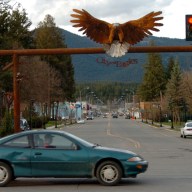 The town of Tasiilaq, east Greenland.
The town of Tasiilaq, east Greenland.
Credit: Anthony Johnston
Driving by sled across the sea ice on the picturesque Tasiilaq fjord in east Greenland, my guide, a rosy-cheeked Inuit seal hunter, urges on his 14 dogs as we push on towards the mountains. All of a sudden, a snowmobile like a dart overtakes us. “Today, youngsters prefer them to dog sleds,” Dines Mikaelsen tells me, gesturing to the fast-disappearing motor vehicle with his sealskin whip.
It’s easy to see this moment as a metaphor for the country itself. Greenland, a self-governing Arctic nation of just 57,000 with the Danish Kingdom, is keen to invigorate its traditional economy of fisheries and hunting, by tapping into the vast mineral wealth worth billions of dollars, now exposed due to the receding ice caps. “In the past, we’ve relied mainly on fisheries which made the economy very fragile,” Greenland’s Prime Minister Aleqa Hammond told reporters in Copenhagen last month. “We need another way to stabilize the economy, and that will be mining.”
To kickstart Greenland’s mineral rush, the government looks set to end its ‘zero tolerance’ policy on uranium mining, which could lead to mining of rare earth metals commonly used in making smartphones, laptops and other electronic devices. This will allow for mineral production at Kvanefjeld, the world’s largest deposit of rare earths, which will offer the country an opportunity to compete with China which controls over 90% of global output in these minerals. Recent geological estimates show that below Greenland’s ice sheet there are enough rare earths to satisfy a quarter of world demand in the future.
However, mining for rare earths will also mean mining for uranium, which is tied up with the elements – and prospecting radioactive materials could threaten Greenland’s pristine nature, argue critics. “If radioactive tailings drop into the fjord, we would have problems calling our waters and fish the cleanest in the world,” says Mikkel Myrup, the chairman of Avataq, a local environmental group that headed an appeal last month by 48 NGOs protesting the decision to end the moratorium on uranium mining. “As long as there are those saying it’s dangerous, I would never accept it,” says Avaaraq Olsen, a 28-year-old primary teacher and elected municipality official living in the town of Narsaq, just a few kilometers away from the Kvanefjeld site.
Meanwhile, the site’s owners have been downplaying the risks, despite the fact that final ecological assessment reports are yet to be released. “That appeal [by Avataq] instilled a lot of fear. The idea of apocalyptic devastation clearly shows a lack of understanding on how these projects work,” Rod McIllree, CEO of Australian-based Greenland Minerals and Energy, told Metro. “But it all needs to be taken within the broader context that Greenland needs a mining industry.”
Once in full production, the royalties from the Kvanefjeld site alone will boost Greenland’s GDP by 20%, says McIllree. Indeed, this money could help the country become independent from Denmark, which currently subsidies more than half of the island’s total budget. Independence from their former colonial master is an alluring prospect for Greenland, nearly 90% of the population being indigenous Inuits. “I hope that one day Greenland will be independent – something I share with many Greenlanders,” says Ingo Hansen, who runs a men’s clothes store in the capital Nuuk. “But our economy has to improve before that can happen.”
But given the paltry number of people here in the world’s most sparsely populated nation, Olsen wonders how independent the country would actually be. “I think it’s very important not to be blinded by the word ‘independence’. What happens when all the minerals are mined, what then for Greenland?”
















